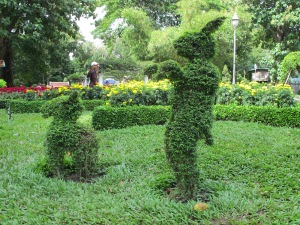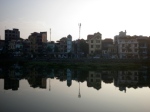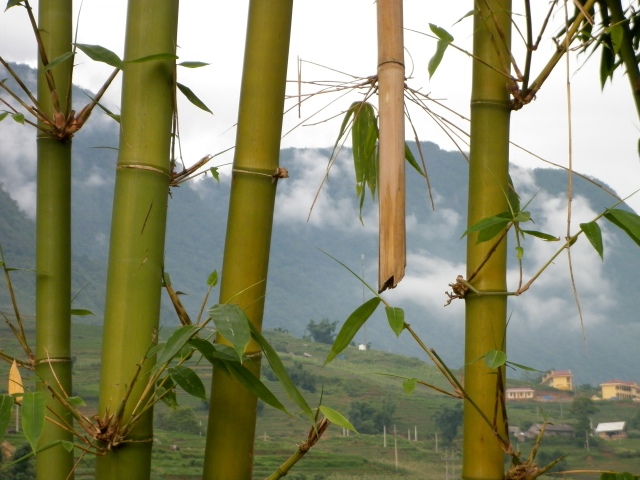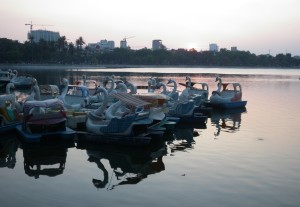
Swan boats at Lenin Park, near my house
It’s almost exactly a year since I quit my job and moved to Hanoi. Here are some of the things I have been up to during that time:
Going on the Carnivore diet
Some of my friends may remember my first year of University, when I was vegetarian. If bad karma accumulates for every animal eaten, I have gathered a lot of bad karma in Vietnam. I hope I don’t come back as a frog, a pigeon, a cricket, a cicada, or a buffalo…on a plate. Having your dinner waiting patiently tethered outside your restaurant, looking at you with beautiful big eyes can certainly trigger a sense of guilt (to mention the goats at our favourite bia hoi restaurant). Jellyfish salad, fried cicadas, roasted sparrow…I have eaten them all.
When it comes to food, Vietnam has a way of making me feel like a cave woman – especially when sitting on a tiny plastic chair on a street corner tearing bites out of a roasted chicken leg with my bare hands. Meanwhile, oblivious free-range chickens roam the streets happily.
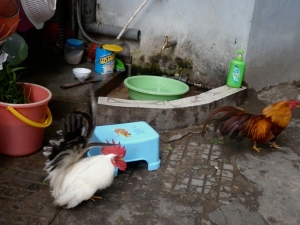
Henny, the cute chicken that lives next to Bret’s house
Riding a motorbike
Student: You should drive a motorbike. A motorbike is the best way to get around in Hanoi.
Me: But isn’t it dangerous?
Student: Yes, it’s very dangerous! But I think you should drive one.
Finally, I have bought my own motorbike. It’s not a cool motorbike – in fact, it’s the kind of motorbike that is usually ridden by the sensible fathers of my students. But I like it. It’s slow. It’s sturdy. It looks like a proper motorbike…not like those newfangled Waves and shiny yellow Vespas.
Driving a motorbike in Hanoi is a bit scary. But somehow I have shifted from my previous position on motorbikes of “never! I value my life! “, to repeating common expat sayings, like “it’s quite safe, because the traffic is so slow”, “it’s probably less dangerous than the bicycle, because it’s more solid” and “it gives me so much more freedom”. The students are right. It’s dangerous, but it’s just so convenient. Plus, it makes my friends back home think I’m super-badass.
Learning to speak Vietnamese.
It remains a bit of a challenge, but contrary to beliefs popularly held amongst expats, the ability to speak it is not magically limited to Men Dating Vietnamese Women. Sure, it’s took a while to manage even the basics, like “I’m from Australia, “how much is this pomelo?” and “no, I’m not married yet”, but in what other country would you receive so much encouragement and praise from the locals on your limited ability to speak the native tongue?
It has thrown light onto some of the things that my students say in English as well. For example, adult students often tell me that they like to “play with their friends” in their free time. Disappointingly, this does not mean that they play hide-and-seek or chasings, as I had envisaged, but is a literal translation of the phrase for spending time with friends in Vietnamese.
Using textbooks instead of making them
No regrets. Teaching is rewarding, often enjoyable, and challenging. I much prefer to work from a cafe/classroom than the office. It’s an independent job, where you don’t have to rely on anyone, and the time I spend at school outside the classroom is minimal.
Before I came to Vietnam, I was quite idealistic about the English teaching, perhaps envisioning it as a way of helping people. And it is, sure, but most of the schools are run as businesses, with education coming second. Most of the students are from the iPhone-toting, growing middle-class of Hanoi, so in that way teaching English for pay differs vastly from volunteer work.
Living in Hanoi has been fascinating and rewarding. There have been a lot of interesting challenges, and I hope that there will continue to be in the future.

A Hanoi street
















